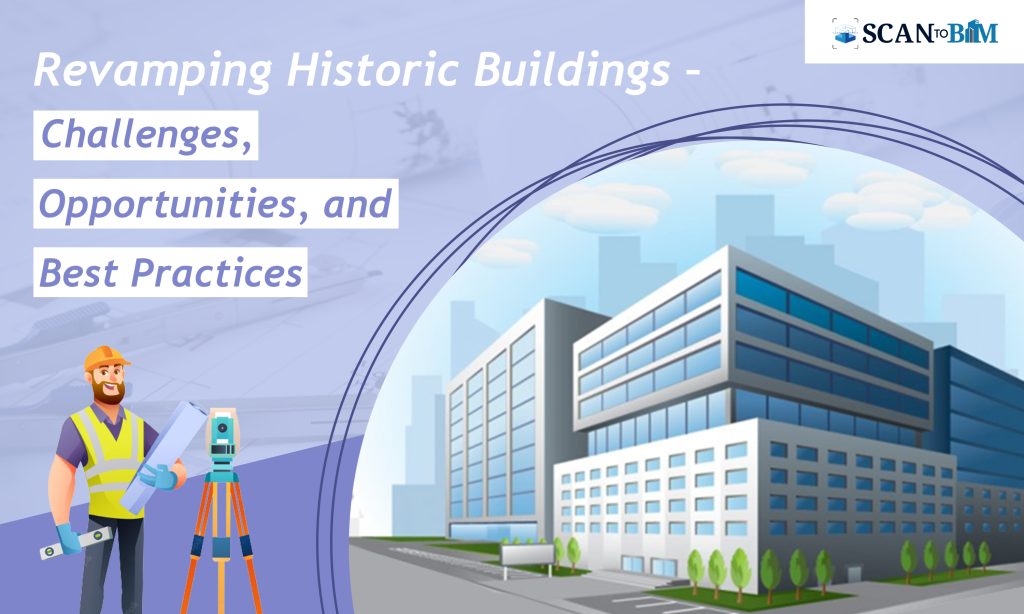
Historic buildings hold a unique charm, carrying stories of the past and reflecting the architectural heritage of our ancestors. As cities evolve and grow, these structures face challenges in maintaining their relevance and structural integrity. Revamping historic buildings presents a delicate balance between preserving their historical significance and adapting them to modern needs. In this blog, we explore the challenges and opportunities involved in revamping historic buildings, emphasizing the importance of preserving our cultural heritage while fostering sustainable urban development.
Key Challenges in Revamping Historic Buildings
- Preservation vs. Adaptation: One of the primary challenges in revamping historic buildings is preserving their original features while making necessary adaptations to serve contemporary purposes. Striking a balance between retaining historical authenticity and accommodating modern amenities can be complex and contentious. Accurate Point Cloud to BIM Services helps in getting the existing and original elements of the historic building in the form of a BIM model.
- Regulatory Hurdles: Historic buildings often come under the protection of strict preservation laws and regulations. While these laws are essential to safeguard heritage, they can pose challenges for developers and architects aiming to bring these buildings back to life. The process of obtaining permits and approvals may be time-consuming and demanding.
- Structural Integrity: Many historic buildings may suffer from age-related wear and tear, making it crucial to assess their structural integrity before any renovation work. Strengthening the foundation and ensuring compliance with safety standards can be a significant challenge, especially for older structures.
- Limited Space and Layout: Historic buildings were designed for a different era and may not have the spatial efficiency required for contemporary use. Adapting layouts to accommodate modern functionalities while preserving the original character can be daunting.
- Materials and Craftsmanship: Traditional construction methods and materials used in historic buildings might be challenging to replicate today. Finding skilled artisans and sourcing authentic materials can be a hurdle in revamping.
- Sustainability Concerns: Striving for sustainability in revamping historic buildings is a necessity to minimize the environmental impact. However, implementing energy-efficient technologies while respecting historical accuracy can be delicate.
Valuable Opportunities in Revamping Historic Buildings
- Preserving Cultural Identity: Historic buildings are integral to a city’s cultural identity. By revamping these structures, we can celebrate our heritage and ensure that future generations connect with their past.
- Tourism and Economic Benefits: Restored historic buildings often become cultural landmarks and tourist attractions, contributing to the local economy through increased tourism and related businesses.
- Adaptive Reuse: Revamping historic buildings allows for adaptive reuse, which breathes new life into these structures without altering their essential character. They can be transformed into museums, galleries, boutique hotels, restaurants, or coworking spaces, serving the community’s needs and fostering cultural engagement.
- Architectural Innovation: The revamping process can allow architects and designers to showcase their creativity with precise
Architectural BIM Services by seamlessly blending historical elements with contemporary design concepts. This integration of old and new can be a unique selling point for the revamped building. - Community Engagement: Involving the local community in revamping fosters a sense of ownership and pride in the restored building. Community engagement can also lead to innovative ideas and solutions for addressing challenges during the project.
- Social Impact: Revamping historic buildings can contribute to urban regeneration and revitalization, breathing new life into neglected areas and creating vibrant public spaces for the community.
Best Practices for Revamping Historic Buildings
- Thorough Research: Comprehensive research is essential to understand the building’s historical significance and architectural characteristics. This knowledge forms the foundation for making informed decisions throughout the revamping process.
- Collaboration and Expertise: Engaging experts, including historians, architects, and conservation specialists, ensure a well-rounded approach to the project, balancing preservation goals with contemporary needs.
- Sensitive Restoration: Prioritize sensitive restoration and repair over complete renovation. Preserve original features and materials whenever possible, using modern interventions discreetly.
- Sustainable Design: Integrate sustainable design principles to minimize the environmental impact of the revamped building. Utilize energy-efficient systems, renewable materials, and green technologies.
- Public-Private Partnerships: Collaborate with government bodies, private enterprises, and non-profit organizations to share resources and expertise for successful revamping projects.
- Education and Awareness: Raise awareness about the importance of historic preservation and the value of revamped buildings to garner public and policymakers’ support.
Preserving the Past, Building the Future
Revamping historic buildings presents both challenges and opportunities in preserving our cultural heritage while fostering sustainable urban development. By striking a balance between historical authenticity and contemporary adaptation, we can breathe new life into these structures while celebrating the past. Through collaboration, sensitivity, and innovative design, we can ensure that historic buildings continue to stand as timeless landmarks that enrich our cities and communities for generations to come.